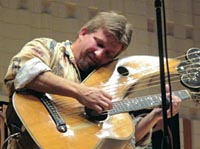
Watch and listen to Stacy's portion of the HGG3 Composing Clinic - introducing the CAGED system to the harp guitar. |
Volume 3, Issue 1, October, 2005
| |
|
“CAGED”
AT LAST by Stacy Hobbs | ||
|
For those of you at Harp Guitar Gathering 3 who cheered on this column, Thank You! I wasn’t sure anyone was listening in….. Our first goal is to play five “C” chords up the neck in each of our “CAGED” positions, finding the link between the shapes as we go. We’re going to tag bass notes to each shape later on. For now play a C chord with your left hand. Now replace your left hand ring finger with your index and play a barred “A” shape at the 3rd fret. This is your second C chord in the “A” position. |
Next, take the part of your barre you're holding down with your left hand ring or pinky (or any other configuration) and replace it with your left hand index finger, fretting the 2nd, 3rd and 4th strings as a partial barre. Stretch the rest of your left hand out to fret a “G” chord proper 2 frets from your barre ! Ouch! That was your third C chord in “G” position. Now replace the left hand ring finger (which should be on the 6th string, 8th fret) with your index finger and play the barred “E” shape we all know and love so well. Your fourth C chord folks! Lastly, replace your left hand pinky from the 4th string 10th fret and place your index finger there instead. Skip a fret and play a “D” shape in front of the barre. Your pinky should wind up on the 13th fret of the B string. Congratulations, you just learned five different “C” chords up the neck. The beauty of this is we can do the same thing with the rest of our positions in the acronym “CAGED.” |
Your goal should be to take the five positions and play their five shapes up and down the fret board. Then you should play a I-IV-V chord progression (starting with the open positions chords) in each of the five keys up and down the neck until you are comfortable with them. Now you can think about the fret board as having only five chords, and the rest are variations on those five shapes. Really?! Yes, hundreds of years of complication distilled down to the “CAGED” system! How simple I must be! Now use your minds to take away the bottom or bass side of your shapes and replace these with your sub bass strings of the harp section...things just got easier! And you’ve maximized the harp guitar for what it does best, giving you bottom end! So go ahead, get CAGED yourself and pick your way out! Stacy |
|
Stacy Hobbs has been performing, recording, and teaching music for the past 23 years. He purchased his first Harp Guitar in 1998, which proved to be his true calling. Visit www.stacyhobbs.net for more! | ||
All Site Contents Copyright © Gregg Miner, 2004,2005,2006. All Rights Reserved.
Copyright and Fair Use of material and use of images: See Copyright and Fair Use policy.
|
If you enjoyed this article, or found it
useful for research, please consider making a donation to The
Harp Guitar Foundation, |
|
|
|
All Site Contents Copyright © Gregg Miner,2004-2020. All Rights Reserved. Copyright and Fair Use of material and use of images: See Copyright and Fair Use policy. |